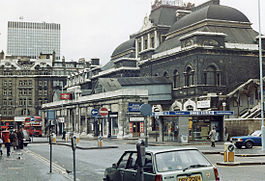Broad Street station (London)
| Broad Street | |
|---|---|

Broad Street station in 1983
|
|
|
Location of Broad Street in Central London
|
|
| Location | City of London |
| Local authority | City of London |
| Grid reference | TQ331817 |
| Number of platforms | 9 |
| Railway companies | |
| Original company | North London Railway |
| Pre-grouping | North London Railway |
| Post-grouping | London, Midland and Scottish Railway |
| Key dates | |
| 1 November 1865 | Station opened |
| 30 June 1986 | Station closed |
| Replaced by | Liverpool Street |
| Other information | |
| Lists of stations | |
| WGS84 | 51°31′08″N 0°05′00″W / 51.51889°N 0.08333°WCoordinates: 51°31′08″N 0°05′00″W / 51.51889°N 0.08333°W |
|
|
|
Broad Street was a major terminal station in the City of London, adjacent to Liverpool Street station. It was opened in 1865 as the main terminus of the North London Railway (NLR) network of suburban services.
The station was built as a joint venture by the NLR and the London and North Western Railway (LNWR) in order to have a station serving freight closer to the City of London. It was immediately successful for both goods and passenger services and saw a significant increase in NLR traffic. Usage peaked in the early 20th century, after which it suffered from competition of London Trams, buses, and particularly the London Underground network. Patronage gradually fell and services decreased, while the station building became increasingly dilapidated. By the 1980s, all freight services had been cancelled, and the station closed in 1986. It was replaced by Broadgate, an office and retail space.
The station was sited at the junction of Broad Street and Liverpool Street in the Broad Street ward of the City of London. Liverpool Street station was immediately to the east. It was near Liverpool Street and Moorgate tube stations.
The station's origins line in the North London Railway (NLR). The line originally opened as the East & West India Docks & Birmingham Junction Railway in 1850, in order to transport freight between the London & Birmingham Railway and the London Docklands. By the time it had been renamed to the NLR in 1853, passenger traffic had grown in equal importance, so it was decided to build a station with direct access to the City of London.
...
Wikipedia

